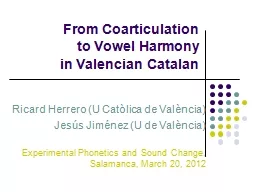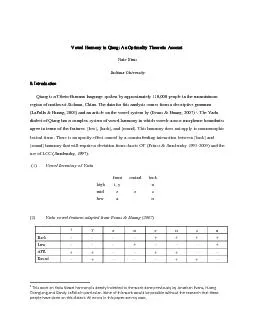PPT-From Coarticulation to Vowel Harmony
Author : relievinglexus | Published Date : 2020-11-06
in Valencian Catalan Ricard Herrero U Catòlica de València Jesús Jiménez U de València Experimental Phonetics and Sound Change Salamanca March 20 2012
Presentation Embed Code
Download Presentation
Download Presentation The PPT/PDF document "From Coarticulation to Vowel Harmony" is the property of its rightful owner. Permission is granted to download and print the materials on this website for personal, non-commercial use only, and to display it on your personal computer provided you do not modify the materials and that you retain all copyright notices contained in the materials. By downloading content from our website, you accept the terms of this agreement.
From Coarticulation to Vowel Harmony: Transcript
Download Rules Of Document
"From Coarticulation to Vowel Harmony"The content belongs to its owner. You may download and print it for personal use, without modification, and keep all copyright notices. By downloading, you agree to these terms.
Related Documents












![r vowel of unclear status is the central l ɵ]. It has been identified](https://thumbs.docslides.com/817969/r-vowel-of-unclear-status-is-the-central-l-it-has-been-identified.jpg)
![the followin! vowel a. [+anterior] { s z } before [i] b. [](https://thumbs.docslides.com/824992/the-followin-vowel-a-anterior-s-z-before-i-b-anterior.jpg)
